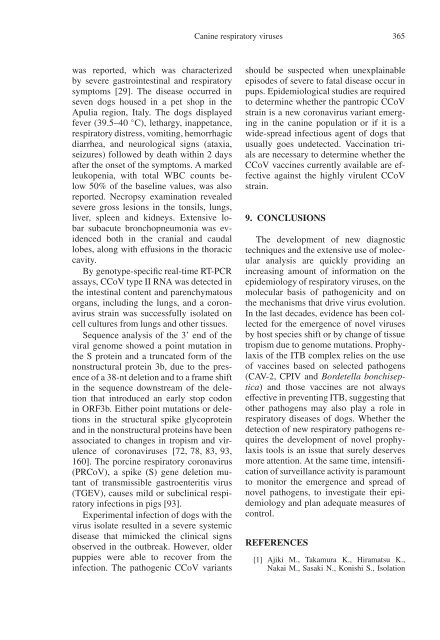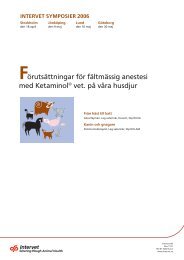KVÄLLSSYMPOSIUM 2008 Vaccinering av hund och katt
KVÄLLSSYMPOSIUM 2008 Vaccinering av hund och katt
KVÄLLSSYMPOSIUM 2008 Vaccinering av hund och katt
You also want an ePaper? Increase the reach of your titles
YUMPU automatically turns print PDFs into web optimized ePapers that Google loves.
was reported, which was characterized<br />
by severe gastrointestinal and respiratory<br />
symptoms [29]. The disease occurred in<br />
seven dogs housed in a pet shop in the<br />
Apulia region, Italy. The dogs displayed<br />
fever (39.5–40 ◦ C), lethargy, inappetance,<br />
respiratory distress, vomiting, hemorrhagic<br />
diarrhea, and neurological signs (ataxia,<br />
seizures) followed by death within 2 days<br />
after the onset of the symptoms. A marked<br />
leukopenia, with total WBC counts below<br />
50% of the baseline values, was also<br />
reported. Necropsy examination revealed<br />
severe gross lesions in the tonsils, lungs,<br />
liver, spleen and kidneys. Extensive lobar<br />
subacute bronchopneumonia was evidenced<br />
both in the cranial and caudal<br />
lobes, along with effusions in the thoracic<br />
c<strong>av</strong>ity.<br />
By genotype-specific real-time RT-PCR<br />
assays, CCoV type II RNA was detected in<br />
the intestinal content and parenchymatous<br />
organs, including the lungs, and a coron<strong>av</strong>irus<br />
strain was successfully isolated on<br />
cell cultures from lungs and other tissues.<br />
Sequence analysis of the 3’ end of the<br />
viral genome showed a point mutation in<br />
the S protein and a truncated form of the<br />
nonstructural protein 3b, due to the presence<br />
of a 38-nt deletion and to a frame shift<br />
in the sequence downstream of the deletion<br />
that introduced an early stop codon<br />
in ORF3b. Either point mutations or deletions<br />
in the structural spike glycoprotein<br />
and in the nonstructural proteins h<strong>av</strong>e been<br />
associated to changes in tropism and virulence<br />
of coron<strong>av</strong>iruses [72, 78, 83, 93,<br />
160]. The porcine respiratory coron<strong>av</strong>irus<br />
(PRCoV), a spike (S) gene deletion mutant<br />
of transmissible gastroenteritis virus<br />
(TGEV), causes mild or subclinical respiratory<br />
infections in pigs [93].<br />
Experimental infection of dogs with the<br />
virus isolate resulted in a severe systemic<br />
disease that mimicked the clinical signs<br />
observed in the outbreak. However, older<br />
puppies were able to recover from the<br />
infection. The pathogenic CCoV variants<br />
Canine respiratory viruses 365<br />
should be suspected when unexplainable<br />
episodes of severe to fatal disease occur in<br />
pups. Epidemiological studies are required<br />
to determine whether the pantropic CCoV<br />
strain is a new coron<strong>av</strong>irus variant emerging<br />
in the canine population or if it is a<br />
wide-spread infectious agent of dogs that<br />
usually goes undetected. Vaccination trials<br />
are necessary to determine whether the<br />
CCoV vaccines currently <strong>av</strong>ailable are effective<br />
against the highly virulent CCoV<br />
strain.<br />
9. CONCLUSIONS<br />
The development of new diagnostic<br />
techniques and the extensive use of molecular<br />
analysis are quickly providing an<br />
increasing amount of information on the<br />
epidemiology of respiratory viruses, on the<br />
molecular basis of pathogenicity and on<br />
the mechanisms that drive virus evolution.<br />
In the last decades, evidence has been collected<br />
for the emergence of novel viruses<br />
by host species shift or by change of tissue<br />
tropism due to genome mutations. Prophylaxis<br />
of the ITB complex relies on the use<br />
of vaccines based on selected pathogens<br />
(CAV-2, CPIV and Bordetella bonchiseptica)<br />
and those vaccines are not always<br />
effective in preventing ITB, suggesting that<br />
other pathogens may also play a role in<br />
respiratory diseases of dogs. Whether the<br />
detection of new respiratory pathogens requires<br />
the development of novel prophylaxis<br />
tools is an issue that surely deserves<br />
more attention. At the same time, intensification<br />
of surveillance activity is paramount<br />
to monitor the emergence and spread of<br />
novel pathogens, to investigate their epidemiology<br />
and plan adequate measures of<br />
control.<br />
REFERENCES<br />
[1] Ajiki M., Takamura K., Hiramatsu K.,<br />
Nakai M., Sasaki N., Konishi S., Isolation





